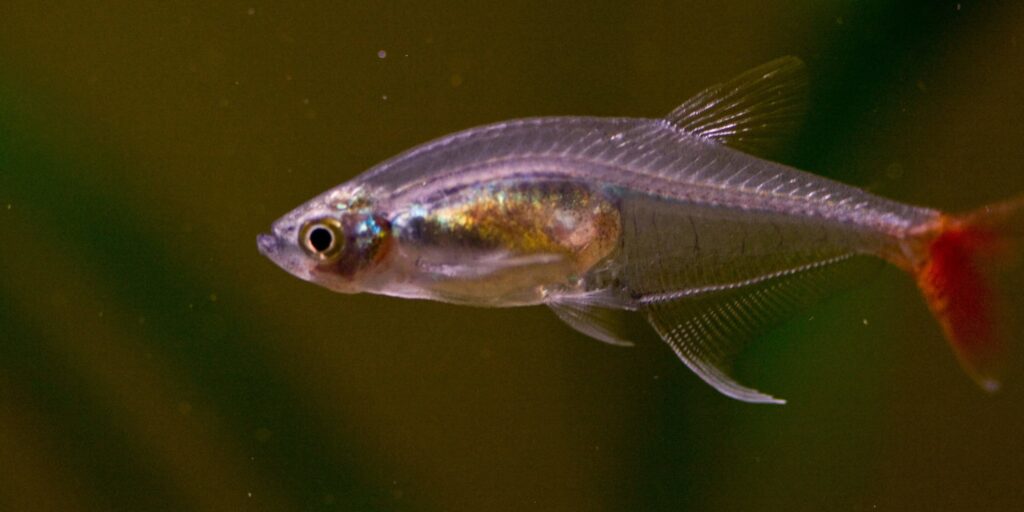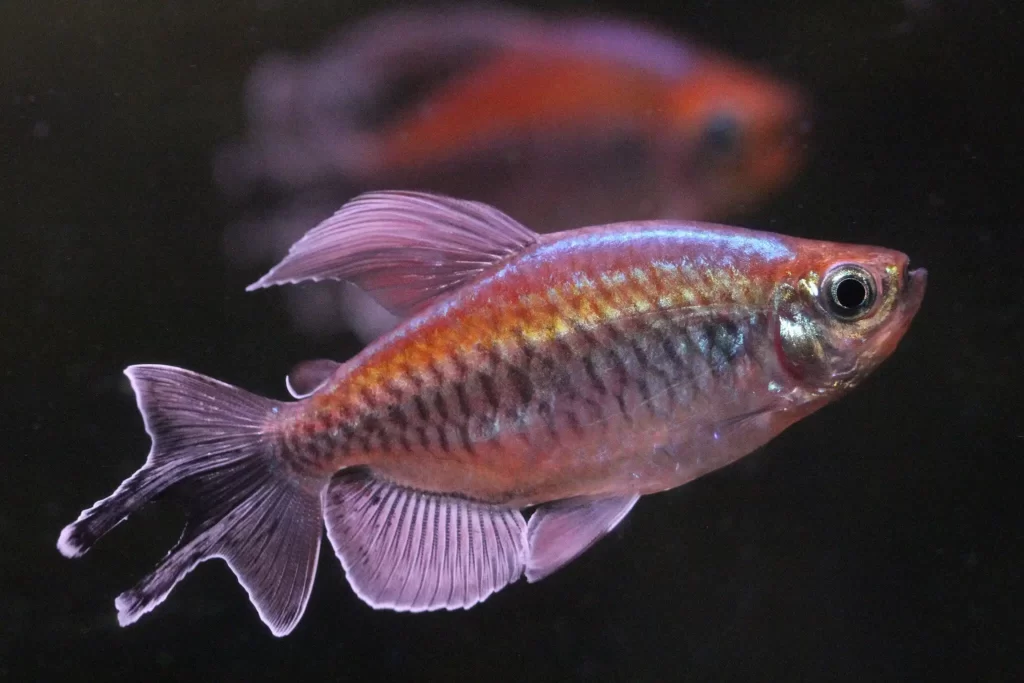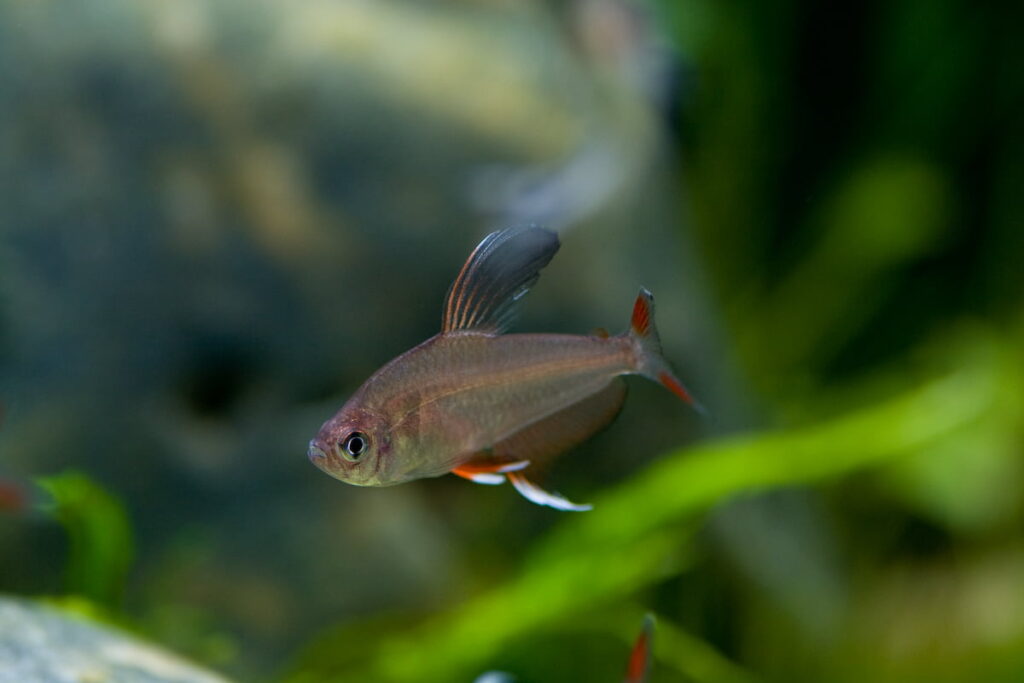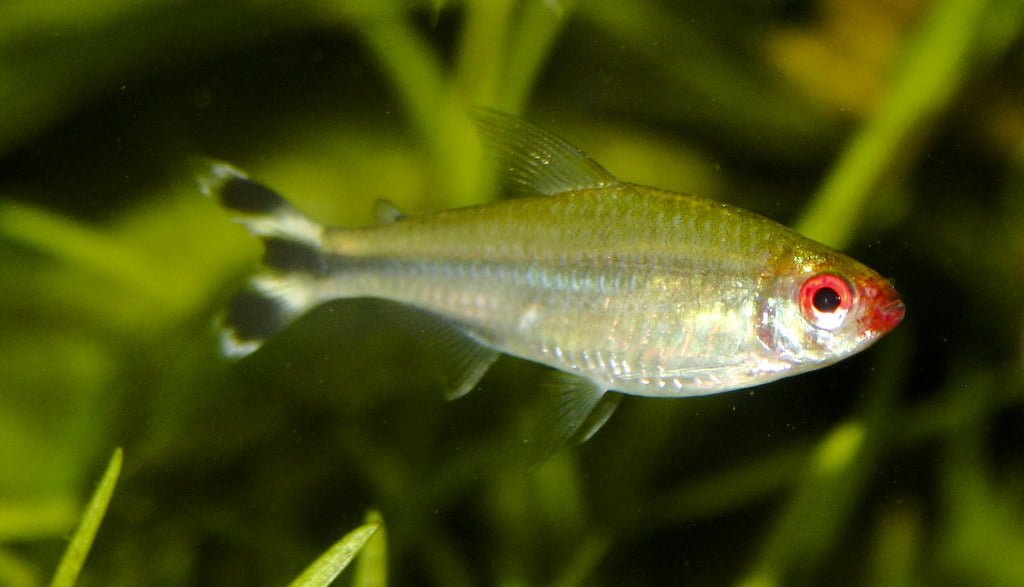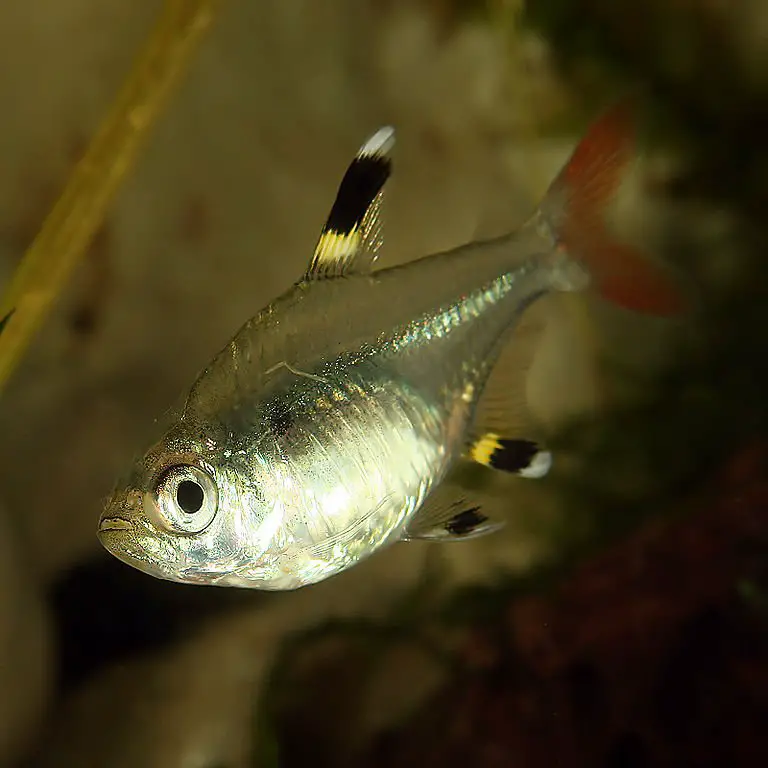Hi, I’m an aquarium hobbyist and I’ve been wanting to add a new fish to my aquarium. As of my limited time as a university student, I’ve been researching the ideal fish for my situation. Out of all the Tetras that exist, “Glass Blood Tetra” was the one that grabbed my attention. For a novice like me, the question arises: “Is Glass Bloodfin Tetra the Ideal fish you’ve been looking for?”
One of the most gorgeous Tetra with a colored scheme, a long-life span, small size, and easy to care for, is none other than the Bloodfin Tetra. Soothing the sore eyes, Bloodfin Tetra, from South America is an active freshwater Tetra.
The noteworthy resilience of Bloodfin Tetra is what makes them an ideal match for any aquarium hobbyist.
Named after its blood-red colored fins and tail, this Tetra is a mid-dweller that has a discrete glass-like appearance.
Bloodfin Tetra is also known by the name: “Glass Bloodfin Tetra”, “True Bloodfin”, “Redfin Tetra”, or “Glass Bloodfin”.
To discover how Bloodfin Tetra has been able to make a good impression for beginners, keep up with me throughout the article!
Fish Classification
| Category | Rating |
|---|---|
| Scientific Name | Aphyocharax anisitsi |
| Common Names | True Bloodfin, Glass Bloodfin, Red Finned Tetra |
| Origin / Habitat | South America river basins |
| Family | Characidae |
| Color Form | Blood-fin tetra is silver in color and has a slim and laterally compressed body with forked caudal fin. The caudal, dorsal, anal, and adipose fins are red in color. |
| Adult Size | up to 2 inches (5 cm) |
| Lifespan | 6 to 9 years |
| Fish Behavior/Temperament | Fin nippers if kept alone. So, keep them in a school of at least 6 but watch closely for minor fin nipping. |
| Water Temperature | 70°F - 80°F (21°C - 27°C) |
| Water Hardness | 5° to 10° dH |
| Water pH | 6 - 8 |
| Water Movement | Keep the water movement moderate. If there are areas on the aquarium for them to rest against the current, they love the flow. |
| Lightings | Requires the lights to be on at least 10-12 hours a day. The light watt will depend on factors like aquarium size, amount of substrate, the density of plants. |
| Tank Region | Middle to Top |
| Tankmates | A peaceful fish that's best kept in a small school. |
| Diet and Food | Omnivore; accepts any form of food like live food, frozen food, flake food, and pellets. |
| Gender Difference | It can be hard to determine; females may be more full-bodied and have less red on the fins. Males are usually streamlined with more red on the fins. |
| Breeding Difficulties | Egg layers, challenging to breed. |
| Tank Setup | Freshwater[Planted] |
| Disease | Columnaris, Dropsy, Eye-Cloud / Cloudy Eyes, Gill Parasites, Anchor Worm, Ammonia Poisoning, White Spot Disease or ICH, Fish Lice, etc. Learn more about:- Tetra Fish Disease and Treatment. |
| Aquarium Size | 20-gallon minimum (keep in small schools) |
Introduction to Glass Bloodfin Tetra: Portrayal Around The World
I hope you are ready to find more details about the Glass Bloodfin tetras. Read further to know their origin, price, water condition requirements, care as well as breeding of the bloodfin tetras.
Origin, Distribution in the Wild, Habitat
Originating from the Paraná River, Argentina basin in South America, Bloodfin Tetra is a small freshwater fish.
Dating back to the discovery in 1903, these Tetras are inhabitants of shaded areas with floating and overhanging vegetation. The Bloodfin Tetras are found in streams, rivers, and tributaries of Rio Parana.
Bloodfin Tetra is a species that is commercially bred in mass. It can easily be available in tropical climates.
Appearance
Besides this, Glass Bloodfin Tetra is distinguished by its bright red fins, slim body, and transparent silvery appearance.
It has a display of colors ranging from beige-orange to silver and even neon highlights. Generally, Bloodfins can grow up to 2 inches long and are long-lived fish.
Price
This beautiful species is readily available in the market where a pair can cost around $6. Because Tetras are community fish and are better-schooled in a group of 6, the fish might cost you around $18.
Life Span
On average, Bloodfin Tetras live up to 6 years, be it wild or captivated. However, if taken care of properly, they can survive for a decade.
Sexual Difference
With a minimal difference, you can differentiate your Tetra based on their visual characteristics. Male Bloodfin Tetras tend to be more vibrant with the appearance of a small hook-like structure on the end of the anal fin, while the females are plumper, rounder, and bigger.
Social Behavior And Tankmates
If there’s one thing that you don’t need to worry about, it is the social behavior of Bloodfin Tetras. This shoaling species is compatible with other fish in terms of their peaceful behavior.
Bloodfin Tetras, like other Tetras, are a reliable community fish best kept in a school of 5 or more.
Being quite skittish, this species may exhibit fin- nipping and aggressive behavior if felt threatened.
They are actually active yet slow swimmers as opposed to their closely related genus; Diamond and Lemon Tetra.
Since these fish like to dwell in the mid and surface level, they will do great with any fish of similar size.
Bloodfin Tetras go well with surface dwellers and fish like other Tetras, characins, Corydoras catfish, snails, Loricariids, Guppies, barbs, etc. However, they can overtake small species while feeding.
Glass Bloodfin Tetra Fish Keeping Difficulty
As a beginner, we need to understand that fish are delicate creatures, and Bloodfin Tetra is one of them.
This means you need to set an environment for them such that they feel comfortable as if it were the actual habitat. This can be done by trying to create a similar accommodation with a good quality of life.
Bloodfin Tetras require an intermediate level of care. Because the Bloodfin Tetras are adaptable to a range of water conditions, they are easier to maintain for anyone.
Fact: Bloodfin Tetras do not necessarily require a heater.
Sure, previous experience would help in your journey of fish keeping. But for a beginner, you need not worry because with these basic factors you will be good to go.
Glass Bloodfin Tetra Care
Caring for the Bloodfin Tetra is easy since it is an extremely hardy fish. It can survive in a wide range of water conditions a little more than other Tetras.
However, this does not mean that it does not require care at all. You need to put in an effort, just a little less than other fish.
This is what makes the fish so popular among beginners. Let’s jump in to see what this fish requires.
Tank Size
A tank set-up for the first time might be confusing because it consists of a lot of elements. The main things a novice needs to consider are the size of the fish, the capacity of the tank, and equipment.
Bloodfin Tetra can grow up to 2 inches. Although small in size, Bloodfin Tetra is an active fish, that is why a minimum of the 20-gallon capacity tank is required.
Aqueon Aquarium is an ideal choice if you are getting an aquarium with a 20-gallons capacity.
A 20- gallon tank is the minimum requirement for any beginner. This includes schooling for 6 Tetras at max. Live vegetation like Java moss is easily available, which is a must in a tank.
Another thing with Bloodfin tetras is that you need to have a secure lid at all times in your tank.
Lighting
Lighting can create a major impact on the performance of the fish. Some fish prefer bright lighting where some prefer a dim environment.
Since Bloodfin Tetras are mostly found in shaded areas with overhanging vegetation, it can be said that they require moderate lighting.
A darker environment setting can be achieved by lower output LED that saves cost as well as enhances the color of the fish.
However, lighting must be adjusted well such that the plants also get enough light for their survival.
NICREW ClassicLED Aquarium Light is an ideal choice for the aquarium with these tetras demanding low output.
Substrate and Décor
A substrate being the base and the décor will visually enhance your fish and your tank. Bloodfin Tetra generally prefers river sand.
This bed of substrate can be adjusted to a darker tint as it enhances the brilliant color of the Tetra. A live plant setting means soil-based substrate as well as a few nutrients for the plant.
Bloodfin Tetras don’t need much usage of decorations. Driftwood, some twisted branches here and there along with some surface plants are all you’ll need to have. Additionally, some dried leaves, stones, and branches can also be added.
Tip: Always make sure that you thoroughly clean anything before you place it into your aquarium.
Glass Bloodfin Tetra Diet
Feeding Bloodfin tetras is the easiest among all when comes to their diet. Bloodfin Tetra is an omnivore.
They are non-needy nor are picky eaters. In the wild, they feed on anything they can find like worms, insects, and crustaceans.
Food flakes are your best friend if you plan to keep Bloodfins. Occasionally treating them with bloodworms, brine shrimps, and frozen food will help maintain a healthy diet. Dried food, vegetables, and pellets will also do for Bloodfin tetras.
Read Full article on Tetra Fish Diet
Always feed in an amount that the fish can consume within 3 minutes. Bloodfins need feeding at least twice a day. Feeding has never been so easy.
Water Quality Maintenance For Glass Bloodfin Tetra
Having healthy livestock is the result of regular maintenance. As a beginner, you need to consider terms like water changes, testing kits, and quality of water. This is because water quality is never constant.
A good thing for starters is that Glass Bloodfin tetras can survive in a wider range of water conditions than most other fish.
This is what makes the fish so easy to include in your tank. Let’s see to which condition the species can thrive.
Temperature For Glass Bloodfin Tetra
Bloodfin Tetras can survive at a temperature from 64°F – 82°F (17.8°C – 28°C). This is the reason why a heater is not necessary for the fish.
It can easily thrive in any environment as long as the temperature is above 18°C which is a great start. You will require a temperature of 76° F – 80° F (24 – 26.6° C) for breeding.
Fact: During breeding, an increase in temperature can result in greater activeness.
Hardness For Glass Bloodfin Tetra
Bloodfin Tetras are known to have a wide tolerance range in terms of water hardness. These Tetras can survive within a range of 2 – 30 dGH.
This means the amount of unrefined minerals in water is more. A water testing kit always comes in handy for this purpose.
pH In Glass Bloodfin Tetra Tank
Bloodfin Tetras require a pH level of 6.0-8.0 to be maintained. This is a bigger range of thriving nature of the fish. This freshwater fish can survive in high alkaline water as well.
Tip: Always have a water testing kit like API master test kit for any fish.
Filtration Of Glass Bloodfin Tetra Tank
Filtration is such an important factor in fish keeping. Filters help manage the algae growth and keep the bacterial colony intact. The type of filter to use will depend on the size of the fish.
Internal and external filters available in the market will vary in terms of capacity, cost, and media.
Going for a Bloodfin Tetra, a hang on the back filter is recommended if you want to give some space in the tank. Usually, a sponge filter in the tank will do a good job as well.
If you are going to tank a fry then you will need to lower the filter suction capacity so that the fry does not get sucked.
Regular water changes need to be maintained in a tank. A 10-25% partial water change every week is the minimum requirement for any tank.
Along with this, trimming grown plants and vacuuming the substrate to clear out any bio-waste is a good habit to keep the environment clean.
Did you know? Tetras have a special type of teeth which they use when grabbing their prey.
Fish Diseases In Glass Bloodfin Tetra
There can be many causes that lead to fish diseases. A well-maintained tank is equally susceptible to fish disease no matter the quality you provide.
Glass Bloodfin Tetra being able to tolerate different conditions, it’s resilient nature can still be diminished by diseases.
A bloodfin Tetra has the capability to live up to 10 years. This definitely means that they should be taken care of properly to live up to a decade.
As a freshwater fish, Bloodfin Tetra can commonly be prone to:
- parasitic infestations,
- bacterial infections,
- skin flukes,
- Ich, and
- gene inherited diseases
To Cure this, you need to consider the following:
- You should first disinfect any substance you introduce to your tank soak them in water first. This is because anything can carry parasites and bacteria and can affect your fish.
- The fauna of the tank is a parameter that can cause stress to the fish. Choosing a species that can perform in coordination with Bloodfin tetra is equally important.
- Another way to make them feel at home is by creating a tank with similar habitat as the original habitat.
- Partial water changes help reduce the disease by a lot.
- Maintaining a balanced diet is also a part of a healthy tank.
Note: If you notice that the fish is not well, immediately consider noting the symptoms, finding the disease, curing and quarantining, and treating the fish. However, do not need to worry as you can treat most fish diseases.
For detailed information on tetra fish diseases and cures, visit the article on this particular topic.
Breeding Glass Bloodfin Tetra
Bloodfin Tetras are easily available in the market as their breeding takes place commercially. Breeding the Bloodfin Tetra is an easy process but you need to be careful while doing so.
Breeding Tank Set-up for Glass Bloodfin Tetra
For breeding, you need to pair a single male with at least 2 females in a separate breeding tank. The breeding should take place in a tank with at most 20 gallons capacity to induce spawning.
A low light setting along with plants for the female fish to lay eggs on is an important part.
However, if you wish to separate the eggs from the fish then you can place a mesh between the layers. Ensure to maintain the temperature and environment for the fish.
Dimming the lights and feeding live food like brine shrimp in small amounts can increase the activity by a lot. The temperature here plays an important role during breeding.
To begin with, place the pairs in a breeding tank. The female fish will go into labor soon enough. The male fertilizes the eggs. The requirements for the breeding process are:
- at the most 20-gallon capacity tank
- clumps of moss for the fish to lay eggs
- alkaline pH of 5.5 to 6.5 and hardness of >4°dGH
- the temperature 79 to 84° F (26 – 29° C).
- sponge filter for filtration and aeration.
The breeding process can take anywhere from 24-48 hours. After the fish has laid eggs, wait for a while and then separate the parents. This is important to prevent the tetras from eating their own egg.
Bonus: The fry will develop in 4 days at maximum. At a time, all fry out of 400- 600 eggs released will not make it.
The ones who have survived will be distinct in 3 days after birth. After 4 days, the fry can be fed on micro-organisms which are very easy to cultivate.
Conclusion
A hardy fish like tetra if properly acclimatized will produce the best results. Well, this is definitely true for the Glass Bloodfin tetra.
With a whole lot of tolerable water conditions and such little requirements, the Bloodfin Tetra is definitely a catch for beginners. A soothing sight to the sore eyes, this freshwater fish might be the one sticking with me for a decade. I hope you have found the answer to the question above and I hope the answer to it is: “Yes, Bloodfin Tetra is a really worthy fish for the beginners”.
There are plenty of other tetras that you can explore if you want varieties in the tank. For further details consider my article on different tetra species.
